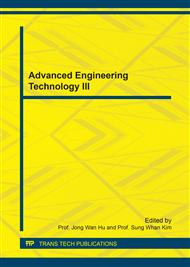[1]
DM 14/01/2008. New Technical Norms on Constructions. Rome, Italy, (2008).
Google Scholar
[2]
DPCM 9/2/2011. Italian guidelines for the evaluation and the reduction of the seismic risk for the built heritage, with reference to the Italian norms of constructions. Rome, Italy, (2011).
Google Scholar
[3]
M. Valente, G. Milani, Seismic assessment of historical masonry towers by means of simplified approaches and standard FEM, Constr. Build. Mater. 108 (2016) 74-104.
DOI: 10.1016/j.conbuildmat.2016.01.025
Google Scholar
[4]
G. Milani, M. Valente, Comparative pushover and limit analyses on seven masonry churches damaged by the 2012 Emilia-Romagna (Italy) seismic events: Possibilities of non-linear finite elements compared with pre-assigned failure mechanisms, Eng. Fail. Anal. 47 (2015).
DOI: 10.1016/j.engfailanal.2014.09.016
Google Scholar
[5]
M. Valente, G. Milani, Seismic assessment of historical masonry towers by means of simplified approaches and standard FEM, Constr. Build. Mater. 108 (2016) 74-104.
DOI: 10.1016/j.conbuildmat.2016.01.025
Google Scholar
[6]
G. Milani, M. Valente, Failure analysis of seven masonry churches severely damaged during the 2012 Emilia-Romagna (Italy) earthquake: non-linear dynamic analyses vs conventional static approaches, Eng. Fail. Anal. 54 (2015) 13-56.
DOI: 10.1016/j.engfailanal.2015.03.016
Google Scholar
[7]
S. Casolo, G. Milani, G. Uva, C. Alessandri, Comparative seismic vulnerability analysis on ten masonry towers in the coastal Po Valley in Italy, Eng. Struct. 49 (2013) 465-490.
DOI: 10.1016/j.engstruct.2012.11.033
Google Scholar
[8]
F. Minghini, E. Bertolesi, A. Del Grosso, G. Milani, A. Tralli, Modal pushover and response history analyses of a masonry chimney before and after shortening, Eng. Struct. 110 (2016) 307-324.
DOI: 10.1016/j.engstruct.2015.11.016
Google Scholar
[9]
C. Modena, M. R. Valluzzi, R. Tongini Folli, L. Binda, Design choices and intervention techniques for repairing and strengthening of the Monza cathedral bell-tower, Constr. Build. Mater. 16 (2002) 385-395.
DOI: 10.1016/s0950-0618(02)00041-7
Google Scholar
[10]
P. Riva, F. Perotti, E. Guidoboni, E. Boschi, Seismic analysis of the Asinelli Tower and earthquakes in Bologna, Soil Dyn. Earthq. Eng. 17 (1998) 525-550.
DOI: 10.1016/s0267-7261(98)00009-8
Google Scholar
[11]
J. Heyman, Leaning towers, Meccanica 27 (1992) 153-159.
DOI: 10.1007/bf00430041
Google Scholar
[12]
G. Milani, R. Shehu, M. Valente, Role of inclination in the seismic vulnerability of bell towers: FE models and simplified approaches, Bull. Earth. Eng. 2016. doi: 10. 1007/s10518-016-0043-0.
DOI: 10.1007/s10518-016-0043-0
Google Scholar
[13]
R. Fedele, G. Milani, A numerical insight into the response of masonry reinforced by FRP strips. The case of perfect adhesion, Compos. Struct. 92 (2010) 2345-2357.
DOI: 10.1016/j.compstruct.2010.03.014
Google Scholar
[14]
G. Milani, R. Shehu, M. Valente, Seismic Upgrading Of A Masonry Church With FRP Composites, Mater. Sci. Forum. 866 (2016) 119-123.
DOI: 10.4028/www.scientific.net/msf.866.119
Google Scholar
[15]
C. N. R, Instructions for the Design, Excecution and Maintance of Static Consolidation Interventions through the use of Fiber-Reinforced Composites, (2014).
Google Scholar
[16]
R. Fedele, G. Milani, Three-dimensional effects induced by FRP-from-masonry delamination, Compos. Struct. 93 (2011) 1819-1831.
DOI: 10.1016/j.compstruct.2011.01.022
Google Scholar
[17]
A. P. Quiroz, S. T. Sperbeck, H. Budelmann, G. Bartoli, E. Bazrafshan, Seismic Risk Mitigation of Historical Masonry Towers by Means of Prestressing Devices, Adv. Mater. Res. 133-134 (2010) 843–848.
DOI: 10.4028/www.scientific.net/amr.133-134.843
Google Scholar
[18]
M. Lualdi, F. Lombardi, Significance of GPR polarisation for improving target detection and characterization, Nondestruct. Test. Evaluat. 29 (2014) 345-356.
DOI: 10.1080/10589759.2014.949708
Google Scholar
[19]
M. Lualdi, F. Lombardi, Combining orthogonal polarization for elongated target detection with GPR, J. Geophys. Eng. 11 (2014) 8.
DOI: 10.1088/1742-2132/11/5/055006
Google Scholar
[20]
T. J. R. Hughes, The Finite Element Method: Linear Static and Dynamic Finite Element Analysis, Comput. Methods Appl. Mech. Eng. 65 (2000).
Google Scholar
[21]
G. Milani, P. B. Lourenço, A. Tralli, Homogenised limit analysis of masonry walls, Part I: Failure surfaces, Comput. Struct. 84 (2006) 166-180.
DOI: 10.1016/j.compstruc.2005.09.005
Google Scholar
[22]
D. Darwin, D. A. Pecknold, Inelastic model for cyclic biaxial loading of reinforced concrete, (1974).
Google Scholar
[23]
P. Fajfar, A Nonlinear Analysis Method for Performance-Based Seismic Design, Earthq. Spectra 16 (2000) 573-592.
DOI: 10.1193/1.1586128
Google Scholar


